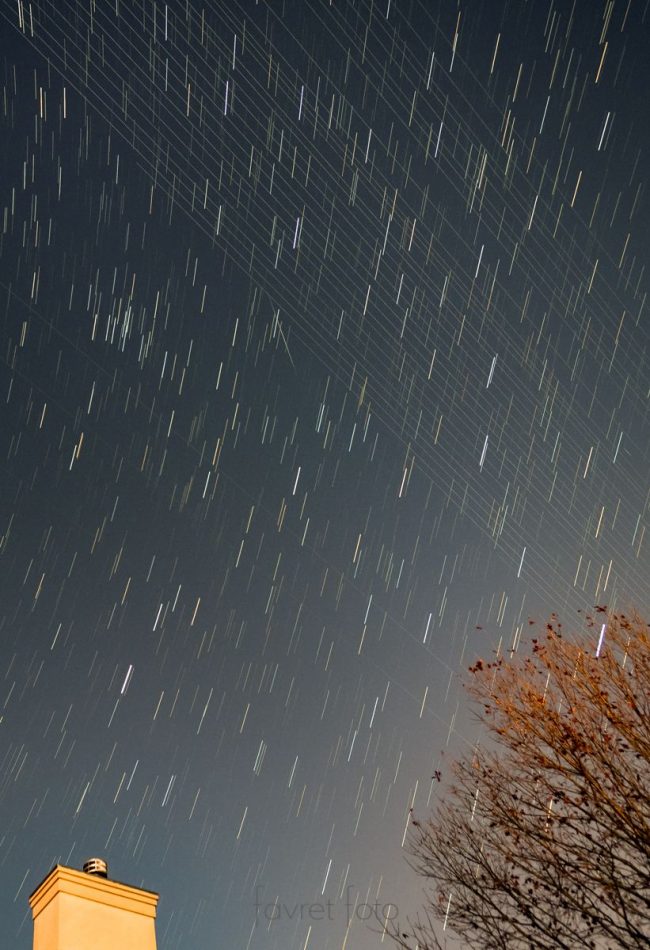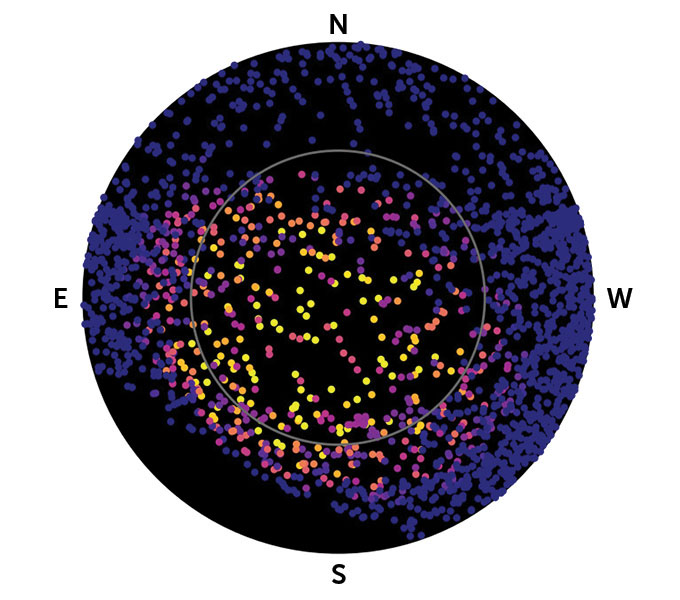
Satellites versus stars
Imagine yourself standing in a rural spot in the dark of night, staring up at the sky. Astronomers estimate that, from a dark site, we see about 2,000 stars with the eye alone. And if we’re lucky, we might also see a satellite, or even two, crossing the sky. But, in the future, a significant of the 2,000 visible “stars” might not be stars at all. A new simulation, released in September 2021, suggests many might be human-made satellites: cutting paths across the stars and constellations, distracting you from the quiet stillness of the night sky. The simulation shows that, soon, every 16th “star” we see in the night sky might be a satellite.
In superhero movies, the battle between good and evil is clear. There are the heroes and villains. In the battle between satellites versus stars, there are no clear-cut villains. Satellites help us. They let us connect easily, every day, to people all across the globe. But various companies now have plans to send thousands of satellites skyward. They’re connecting the satellites into what are called constellations, which are groups of satellites working together as a single system. The best known planned mega-constellation of satellites is SpaceX’s Starlink. There’s also OneWeb, Amazon’s Kuiper and China’s StarNet/GW. Together they’re currently planning to launch a total of 65,000 satellites.
Lovers of the night fear these satellites will pollute near-Earth space to the point that we’ll notice the satellites more than the stars.
Samantha Lawler of the University of Regina in Canada led the team of scientists that created a new simulation of the potential positions and brightnesses of these satellites. They submitted the study to the American Astronomical Society journals for review. A preprint, dated September 14, 2021, is available online.
The Union of Concerned Scientists, which keeps a record of operational satellites, said that – as of January 2021 – there were 6,542 satellites in Earth orbit. Of that total, 3,372 are active and 3,170 are inactive. I corresponded with Samantha Lawler about the difficulty for the layperson in comprehending an increase to 65,000 satellites. It’s not just that there’d be more “stars” in the sky. Because they’re so much closer to us, we’d see these “artificial stars” move. And movement draws the eye. So – on a dark night – when you looked up, your eye would be drawn to the satellites more than the stars. Lawler told me:
Yes! It’s really hard to get that across to people. It’s like we’re building a cage of crawling, bright satellites that will be between us and the stars.

Simulating the sky of the future
SpaceX’s Starlink … OneWeb … Amazon’s Kuiper … China’s StarNet/GW … none of them have shared their exact timeline for when all their satellites will be up in space. But, Lawler said, her team estimates that SpaceX, at least:
… plans to have their whole mega-constellation up within the next 3-4 years, and that is the majority of the 65,000 satellites that we modeled.
Lawler’s team looked at predictions for the brightness and location of thousands of satellite constellations, or mega-constellations.
Their simulations showed that in just a few years, approximately one in every 16 “stars” will be a moving satellite. And in some regions during some times of the year, satellites will appear in the sky all night long instead of just around twilight and dawn. The worst region of the globe will be at latitudes 50 degrees north and south.
Lawler told EarthSky that that number – one in 16 – might be too optimistic:
At the worst, our calculations show that it could be as bad as 1 in 10 point sources in the sky will actually be satellites.
As the scientists wrote in their paper:
Without drastic reduction of the reflectivities, or significantly fewer total satellites in orbit, satcons [mega-constellations] will significantly change the night sky worldwide.
Seeing satellites
It’s true it can be amazing to watch a satellite, or even a train of satellites, crossing the night sky. Satellites shine by reflecting the sun’s light. For this reason, they’re usually only visible during the beginning of night and as morning approaches, when the sun’s rays can still reach them high above Earth. But at latitudes such as 50 degrees north and south, locals will see satellites all night long near the summer solstice, and near sunrise and sunset on the equinoxes.
The video above shows the Starlink satellites a day after launch on April 23, 2020. Note how they eventually get deep enough in Earth’s shadow that the sunlight no longer reaches them. And that’s when they fade to darkness. The video was taken from Switzerland, around 47 degrees north.
The sky as busy freeway?
Lawler happens to live at 50 degrees north latitude. As her simulation shows, the higher latitudes are where satellites are likely to appear in the sky most densely. So it’s personal to her. She said she considers not just how mega-constellations of artificial satellites will affect scientific research, but how they’ll change the appearance of the night sky for all of us. Lawler told Science News:
How will this affect the way the sky looks to your eyeballs? We humans have been looking up at the night sky and analyzing patterns there for as long as we’ve been human. It’s part of what makes us human. We’ll see a human-made pattern more than we can see the stars, for the first time in human history.
She went on to say:
I think we really are at a transition point here where right now, seeing a satellite, or even a Starlink train, is cool and different and wow, that’s amazing.
She compared the novelty of seeing those first Starlink satellites and our future view of them to watching one car go down the road 100 years ago, versus living next to a busy freeway now. She continued:
Every 16th star will be moving. I hope I’m wrong. I’ve never wanted to be wrong about a simulation more than this. But without mitigation, this is what the sky will look like in a few years.

Darkening strategies
Companies that plan to launch mega-constellations of satellites are aware of the issue. They know their bright satellites might ruin the night sky. They say they’re working to mitigate the issue. There are no regulations. So their compliance is voluntary. Some companies are testing shields to reduce the glare. Others are considering moving the satellites into lower orbit so they cross more quickly (though this makes them more visible for some parts of the world).
What’s clear is that unless something is done, the view of our night sky is going to change drastically. According to the United Nations Office for Outer Space Affairs, since 2020, 2,584 more satellites have launched into the sky, bringing the total number of objects launched into space to 7,890. The problem will only continue to grow as we expand our capabilities into space.

Unanswered questions
By the way, Lawler told me that a timeline of the next few years for launching thousands more satellites raises more questions. She said:
Worryingly, that’s also when the next solar maximum is predicted, which always causes satellites to shut down during solar storms … what is that going to do to satellites that have to actively avoid each other?
Lawler also mentioned that the additional satellites increase the danger of the Kessler syndrome. The Kessler syndrome theorizes that eventually, as low Earth orbit gets crowded with satellites, collisions could cause a cascading effect, with debris from one collision triggering further collisions until this area of space where most satellites operate could be rendered useless.
Play with the simulator
Want to know how many satellites you might expect to see where you live, in contrast to other parts of the globe? You can play with the new simulator built by Lawler and her team. It predicts the number and brightness of visible satellites from several mega-constellations. Visit the Mega Constellations Visibility Predictor.
Also, watch the video simulation below. It shows what the sky would look like overhead – during the summer solstice – from 50 degrees north. All the dots mark satellites.
Bottom line: In the battle of satellites versus stars, stars will outnumber satellites. But, as thousands of satellites pile up in near-Earth space, their motion will draw the eye. Many fear the presence of these satellites will drown out the quiet background stars.











